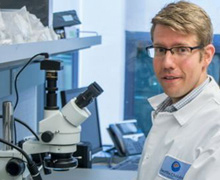Diagnosis and Treatment of Pediatric Genetic Retinal Disorders
Using high-throughput chromatin immunoprecipitation sequencing (ChIP-Seq) to understand retinal development
Technology Overview
 Dr. Timothy CherryDr. Timothy Cherry’s research is focused on using high-throughput techniques to improve diagnosis and treatment of pediatric genetic retinal disorders. Genetic retinal disorders, occurring in 1 in 4,000 births, result in partial or total loss of sight and a high burden on the quality of life for patients and their families. Although genetic mutations in the coding sequences of approximately 250 genes have been identified as contributors to these disorders, only 50% of retinal genetic disorders can be explained by genetic mutations in protein-coding sequences. Dr. Cherry is interested in the underlying genetic mechanism for the remaining disorders.
Dr. Timothy CherryDr. Timothy Cherry’s research is focused on using high-throughput techniques to improve diagnosis and treatment of pediatric genetic retinal disorders. Genetic retinal disorders, occurring in 1 in 4,000 births, result in partial or total loss of sight and a high burden on the quality of life for patients and their families. Although genetic mutations in the coding sequences of approximately 250 genes have been identified as contributors to these disorders, only 50% of retinal genetic disorders can be explained by genetic mutations in protein-coding sequences. Dr. Cherry is interested in the underlying genetic mechanism for the remaining disorders.
Dr. Cherry has utilized high-throughput chromatin immunoprecipitation sequencing (ChIP-Seq) to identify non-coding elements of the genome that are essential for proper retinal development. These elements include enhancers and repressors: the binding sites for transcription factors that regulate gene expression. Using the ChIP-Seq technique, a panel of 40,000 non-coding sequences have been identified as potential mutation sites for diagnosis of genetic retinal disorders. Since non-coding genomic elements are less evolutionarily conserved than coding sequences, Dr. Cherry will use high-throughput assays to determine which mutations are causally related to genetic retinal disorders and which mutations are simply benign variations in the population.
Dr. Cherry’s research has the potential to make a highly significant impact on the treatment of pediatric retinal disorders. In the future, gene therapy or CRISPR gene editing could be used to restore the functionality of transcription factor and non-coding regulatory element interactions, thereby restoring retinal photoreceptor cell function. Normal regulatory elements could also be used to fine-tune existing gene therapies in the eye. Restoring retinal cell function could, in turn, improve sight and quality of life for patients.
Dr. Cherry is interested in industry partnerships that would use sequencing and other high-throughput techniques to develop diagnostics of genetic retinal disorders. He is also interested in partnerships that could potentially use the non-coding genetic mutations he has identified in conjunction with gene therapy or gene editing techniques to improve treatment.
Stage of Development
- Pre-clinical in vivo
- Pre-clinical in vitro
- Pre-clinical ex vivo
Partnering Opportunities
- Collaborative research opportunity
- Sponsored research agreement
- Consultation agreement
- High throughput screening
Publications
- Andzelm MM, Cherry TJ, Harmin DA, Boeke AC, Lee C, Hemberg M, Pawlyk B, Malik AN, Flavell SW, Sandberg MA, Raviola E, Greenberg ME. MEF2D drives photoreceptor development through a genome-wide competition for tissue-specific enhancers. Neuron. 2015; 86: 247-63. PMID: 25801704
- Cherry TJ, Wang S, Bormuth I, Schwab M, Olson J, Cepko CL. NeuroD factors regulate cell fate and neurite stratification in the developing retina. J Neurosci. 2011; 31: 7365-79. PMID: 21593321
- Cherry TJ, Trimarchi JM, Stadler MB, Cepko CL. Development and diversification of retinal amacrine interneurons at single cell resolution. Proc Natl Acad Sci U S A. 2009; 106: 9495-500. PMID: 19470466
Learn More
To learn more about partnering with Seattle Children’s Research Institute on this or other projects, email the Office of Science-Industry Partnerships.
